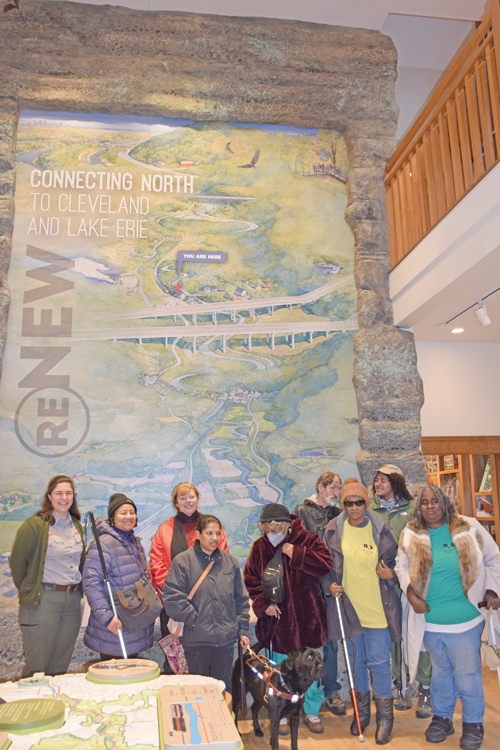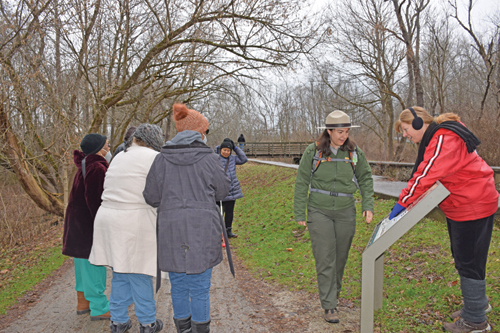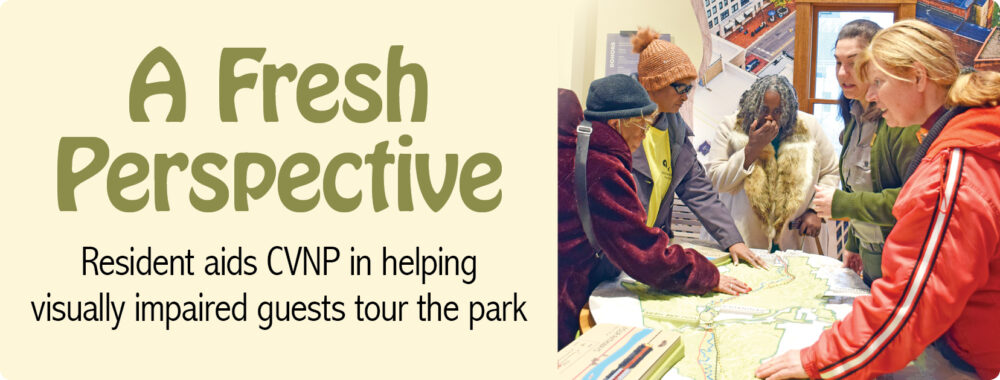Hinckley resident joins CVNP visually impaired focus group
by Chris Studor
The scent of flowers in the air, the sound of spring peepers and the feeling of the year’s first warm rays of sun can all be experienced by walking one of the many miles of trails in Cuyahoga Valley National Park.
For those with visual impairment, the use of the park’s audio brochure and other aides can enrich their experience. Recently, Hinckley resident Debbie Moss was asked to be part of one of two focus groups recently held at CVNP conducted by graduate student, Sajja Koirala. Koirala is doing her graduate dissertation on the use of audio technology in the country’s national parks.
Koirala is legally blind, was born and raised in Nepal and is a graduate research assistant at the University of Hawaii at Manoa. She currently resides in Dayton but travels around the country frequently to do research. The National Society for the Blind provided candidates for Koirala to contact to see if they would be interested in participating in focus groups at CVNP.
Moss was among those contacted after first filling out a questionnaire that surveyed the participant’s level of visual impairment, familiarity with audio descriptions, age, gender, education and more. Permission was then given by CVNP allowing Koirala to conduct focus groups.
“I started my research in 2016 with the goal of determining how audio technology can better be used to support the visually impaired,” said Koirala. “The project especially focuses on trip planning. At this time, there are about 150 parks/historical sites/monuments that have some type of audio technology available to the visually impaired. For this research, I am using CVNP as a typical park along with Pullman National Historic Park in Chicago and Rosie the Riveter National Historic Park in California, so as to include different types of park sites.”
For frequent park visitors, such as Moss, the park’s audio brochure and other aides are paramount to the quality of a visit.
“I go to the Cuyahoga Valley National Park fairly often,” said Moss. “I like to do a lot of pre-planning for all of my trips. National parks can be huge and an audio brochure can really help with pairing down what I would like to experience given the time I have to spend. The audio descriptions help me form a picture in my mind, give me a sense of direction as to where I am in the park and also [helps me] learn the history of the area as well as the plants and animals which may occupy that space.”
CVNP Accessibility Coordinator Arrye Rosser said providing those with disabilities the tools they need to enjoy the park to their fullest “has been a journey in providing those with disabilities with as much information as possible as well as maintaining compliance with all regulations.”
“We want visitors to have their best possible experience in order for them to be as self-sufficient as possible and enjoy their visit as much as possible.” said Rosser.
Rosser said once Koirala completes her study, the feedback she obtains can help to further increase how effective the park’s audio technology is and where it may need to be refined.
Providing for the visually impaired as well as those with other disabilities has been on the forefront at Cuyahoga Valley National Park for many years.
For those wishing to get started exploring the park, Rosser suggested beginning their journey with a visit to Boston Mills Visitors Center. It offers a Braille version and audio version of the park’s map and guide. If you have a smart phone, download the UniDescription mobile app and search for it under Cuyahoga Valley National Park.
The focus group participants also began their experience at the Boston Mills Visitor Center with Park Ranger Jennie Krob providing a short history of the park. She encouraged the participants to run their hands and fingers over the large table top map in order to “feel” the groove in the map representing the length of the Cuyahoga River, as well as the tiny railroad spikes representing the Cuyahoga Valley Scenic Railroad which runs parallel to the river.
Ranger Krob then led the group on a hike to the closest canal lock explaining the importance of the Ohio & Erie Canal and Towpath Trail for transportation and commerce in the 1800s. She also explained how the locks operated.
“The three-dimensional sign at the lock gave me a feel for the many levels the canal boats had to go through and imagine how much time and work it must have taken to lower and raise the boats,” said Moss.
In addition to providing descriptions of the various locks in the park, there are more than 100 locations in CVNP, including most outdoor graphic panels, which have been audio described. There are also hand-cranked audio stations at many locations. The park also offers physical programs as well as partnering with the Cleveland Sight Center to offer a seasonal tandem bike program. The Cuyahoga Valley Scenic Railroad has a Voice of the Valley audio tour available and a train-tracker app for smart phones.
Those in the focus group also conveyed various preferences for how they like audio material to be presented. As one focus group participant said, headphones tend to make her feel isolated. She prefers something that can be pushed, started or cranked at the site of interest which enables her to “give all [her] attention to the audio being played.”
“The park brochure is full of detail and it makes me feel empowered,” said another focus group participant. “I wish it were a bit louder. And, not only with the parks, I wish all places with audio descriptions included directions to and inside the bathrooms.”
Coincidentally, Rosser said measurements and locations of park restrooms are currently being taken “because many visitors with impairments have to plan their visit around restroom accessibility and placement.”
Rosser said the CVNP audio brochure provides a detailed overview of park highlights including; the Canal Exploration Center, history of the Cuyahoga River, Boston Mill Visitor Center, renewal of park resources, waterfalls, transportation, description of the Ledges, Kendall Lake, past and present use of farming in CVNP, Hunt House Visitor Center near the Beaver Marsh, wildlife, lodging and more.
Through past and current work of the CVNP, complimented by outside research, Rosser said the park strives to remove barriers and create fun experiences for everyone.
“When I have an opportunity to learn more about a place of interest, it makes me want to explore even more,” said Moss. “It was a really interesting experience to be a participant in this process in CVNP which is so accessible to those in the Cleveland area which you can visit time and time again.” ∞

Gathering at Boston Mills Visitor Center, Park Ranger Jennie Krob (far left) introduces
the Cuyahoga Valley National Park to a group of visually impaired guests invited to
participate in a focus group conducted by graduate student, Sajja Koirala, (pictured with
a service dog) on the use of audio technology in the country’s national parks. Included
in the focus group is Hinckley resident, Debbie Moss (red coat). Photos by Chris Studor.

CVNP Park Ranger Jennie Krob leads visually impaired guests on a hike to one of the former canal locks along the Towpath
Trail in CVNP as Hinckley resident Debbie Moss examines a raised map on a placard by the lock.
On our cover (photo): A three-dimensional tabletop map at the Cuyahoga Valley National Park’s Boston Store helps those with visual impairments have a sense of place as to where the Cuyahoga River flows in relation to the Cuyahoga Valley Scenic Railroad. The map has a groove in its surface to represent the river and small metal spikes that enable users to trace the path of the railway alongside the river. Hinckley resident, Debbie Moss (front right) was among the visually impaired participants asked to give feedback to graduate student Sajja Koirala, who is doing her graduate thesis on the use of audio technology in the nation’s parks. Photo by Chris Studor.

